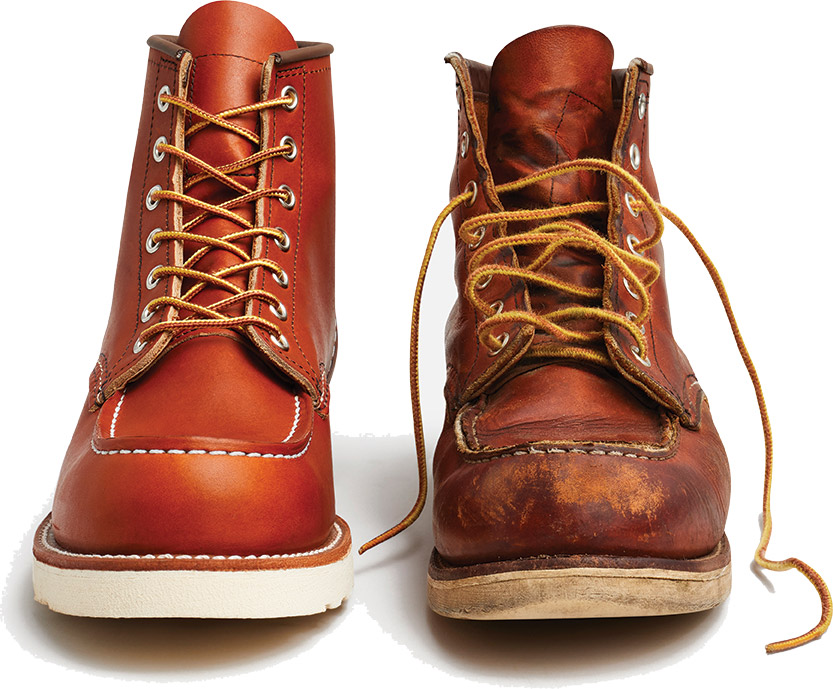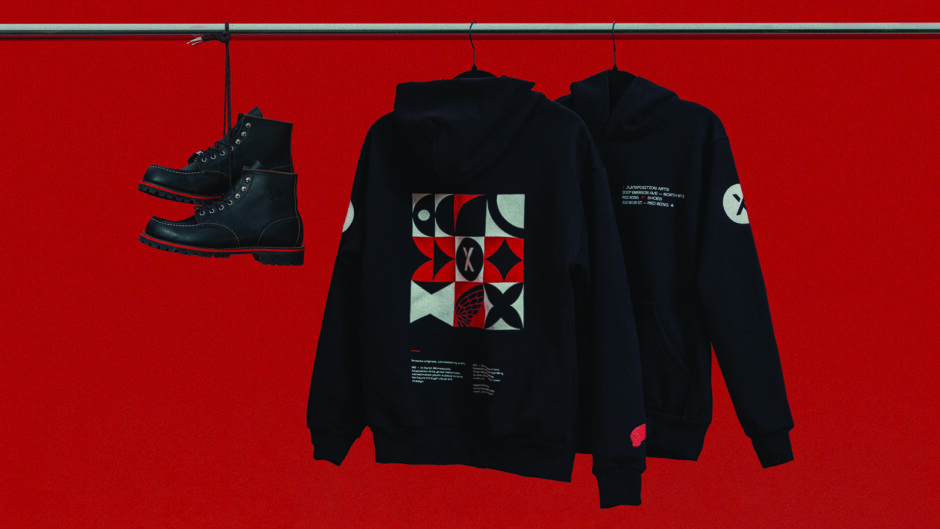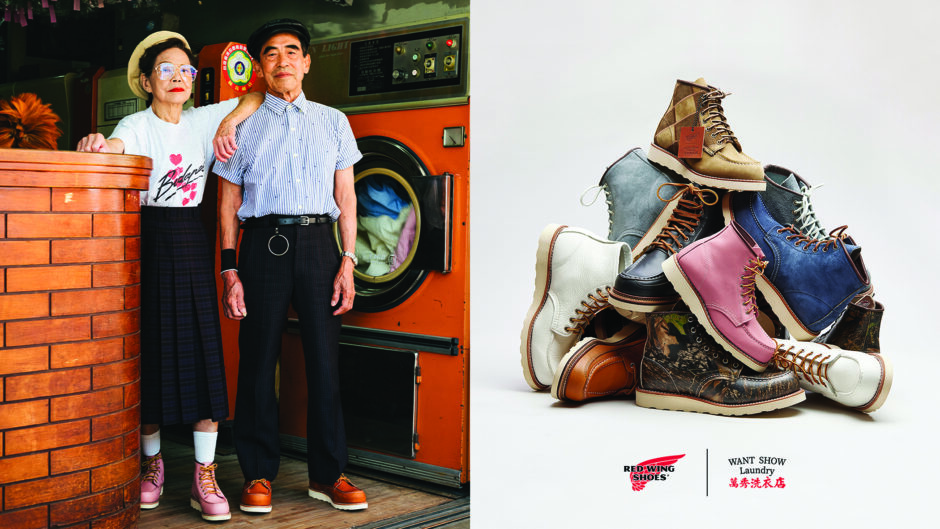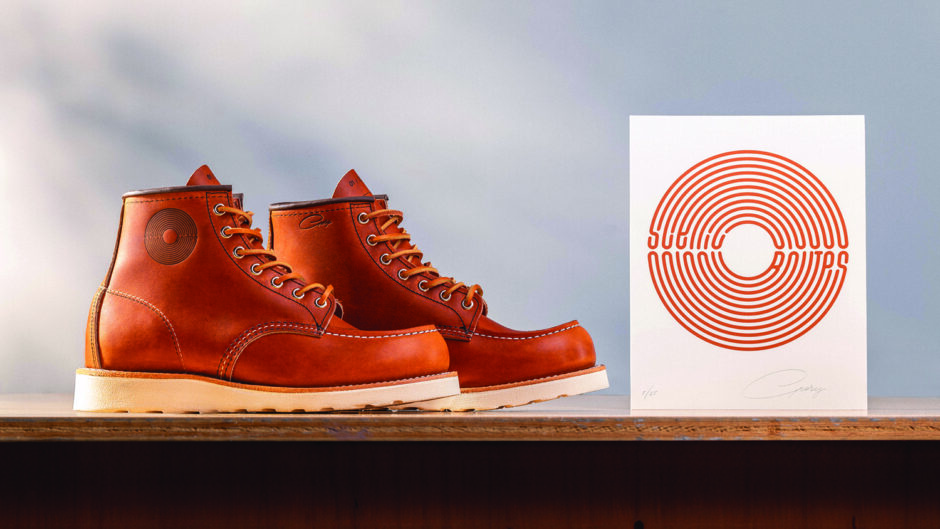
Red Wing’s 6-inch Classic Moc is as quintessentially American as the faded Levi’s and plaid flannels it’s often paired with. You’d be hard-pressed to find a more recognizable footwear silhouette or a more enduring one. After almost seven decades, the iconic boot from Red Wing, MN, has left its crepe-soled footprints on the hearts of everybody from Midwestern deer hunters to entertainment icons to Tokyo trendsetters. And it seems to have a sky’s-the-limit future, expanding successfully into women’s, new colorways, and a series of creative collaborations.
Introduced by Red Wing in 1952 as a hunting boot, the Classic Moc was—and still is—handcrafted by skilled makers in the USA with leather from the now fourth-generation, family-owned company’s tannery. (According to Red Wing literature, it takes more than 230 steps to build each pair by hand.) “Moc” is short for moccasin, the Algonquin word for shoe, a nod to the fact that the toebox design was inspired by traditional Native American footwear.
The Classic Moc soon found its way from the woods to the farms and factories of the heartland, hardly surprising since many of the men who hunted on the weekends spent their work weeks in those places. Laborers recognized that the boots were durable, comfortable (after you wore them a few times to break the leather in), water-resistant, lightweight, and slip-resistant thanks to their crepe rubber outsoles. In short, they were a perfect fit for work. Red Wing realized this too and created a steel toe work version of the Moc (also available with an 8-inch upper) that became as popular as the hunting one.
Classic Mocs became Red Wing’s #1 seller, a title the style still holds today. Over the decades, the company has sold millions of pairs of its OG favorite—a feat made more impressive by the fact that the boots are resoleable, durable enough that they’re sometimes handed down from generation to generation, and so sought-after as vintage finds that pre-owned pairs can command prices on eBay above the current $300 starting point for new ones.
Big in Japan
So how did the Classic Moc, with its unpretentious origins and salt-of-the-earth DNA, become a thriving lifestyle brand, chic enough to show up in the pages of GQ and on the feet of David Beckham and Ryan Gosling? That’s the surprise twist to the story: Red Wing never expected its boots to become a style statement. It just sort of…happened.
In the mid-’70s, Japanese youth fell hard for all things Americana—and one of the items they coveted most was Red Wing Classic Moc work boots. At home in Minnesota, people bought Mocs for function, but in Tokyo, they were the height of fashion. They remained a top selling lifestyle look in Japan for decades, but it wasn’t until the tourism boom—when Americans started flocking to Japan in the late ’90s and early ’00s—that the boomerang effect kicked in. Travelers from the U.S. saw what the Japanese were wearing and suddenly realized Classic Mocs were cool, so they came home looking to buy a pair, too.
J. Crew picked up on the trend and approached Red Wing in 2007 with a view to buying 3,000 pairs of Classic Mocs. As the story goes, they sold out almost immediately and Red Wing realized it needed to create a lifestyle division in North America. Thus was born Red Wing Heritage.
Since its formation in 2008, Heritage has rolled out Classic Mocs in a rainbow of colors—50 to be exact—from Indigo blue to Alpine green, according to George Curleigh, president of the division. They’ve also overseen a number of highly collectible limited-edition collaborations ranging from dressing the boot up in Woolrich plaids to inviting artists to put their creative stamp on the uppers. (See sidebar.)
Subtle Upgrades
Along the way, Red Wing has made a number of invisible improvements to the Classic Moc’s design. “It looks exactly the same, but every few years we tweak the rubber, the durability, the cushioning, the grip, the technology,” Curleigh explains. “Most people don’t know it, but the white sole is actually Vibram technology. That’s why it has such good grip.”
Other aspects of the process haven’t changed a bit over the years. Red Wing, founded in 1905 and owned by the same family since 1914, still uses its venerable Puritan stitch machines, time-tested workhorses that create the Moc’s durable triple-stitch detail. “Our biggest challenge is that those machines haven’t been made for decades, so we have to repair them and custom-make tooling,” says Curleigh. Likewise, the company’s S.B. Foot Tanning Company in Red Wing, MN, dates from the 19th century and still uses old-fashioned wooden drums.
Then there’s the Goodyear welt construction, a process that dates from 1869 and enhances the boot’s durability. “It’s very labor-intensive and requires skilled workers,” Curleigh says. “You can’t just find someone off the street. It takes years to learn these skills.”
Combine durable construction with a never-out-of-style silhouette, and you get a sort of built-in sustainability: a boot that lasts for decades and is repairable, says Curleigh. (There are more than 1,600 certified Red Wing cobblers, and the factory repairs the boots of owners who mail or bring them in.) You could even argue that the Classic Moc is recyclable in the sense that so many pairs get handed down in families and resold because age ups their appeal to much of the fanbase, he adds.
Better Over Time
“Everybody likes the look of good quality leather that has aged well,” says Nick English, owner of the boot blog Stridewise. “It’s got patina. It exudes timelessness, durability, masculinity, care taken, a ready-for-anythingness. There are a lot of leather boots out there, but there aren’t many with the leather quality of Red Wing.
“It’s not just the fact that the boots can be resoled, but the fact that they look better with age. People like the look of a new pair of these boots; they love the look of an old pair,” he adds. “You’ve gotta earn that age. They’re sort of like faded jeans in that regard. And for made-in-America, Goodyear-welted boots, they’re very reasonably priced, which has helped to cement their place in pop culture and footwear [fame].”
English says Red Wing’s Classic Mocs hold a special place in his heart. “It was my very first boot,” he recalls. “I’m from the tropics of Australia, where boots aren’t really a thing. When I moved to New York I suddenly needed boots to manage the snow and the gutters. I did weeks of research and got the charcoal Red Wing Classic Moc in 2014. That boot started my whole career. I couldn’t find the informational resource I wanted, so I started my website. Now I travel all over the world learning about boots. And I still have my Mocs. I got them resoled with red stitching, which looks really good with the gray.”
Cult Following
Most American members of Moc nation come to the brand the way Nick English did—organically. “Even though it’s been around for a long time, the Classic Moc is still an underground fashion in North America, and Red Wing is still a discovery brand,” says Curleigh.
The cult of the Classic Moc certainly includes A-listers (Ryan Gosling is famously a fan), but Red Wing doesn’t seek out stars. “We don’t pay famous musicians to wear our boots at the Grammys,” says Curleigh. “People wear them because they want to. They’ve discovered the brand themselves.”
In what might be deemed characteristic Midwestern understatedness, flying almost under the radar in its home country suits Red Wing just fine. “Our goal is to smoke but never catch on fire,” Curleigh explains. “As soon as you catch on fire, you become so popular you know that in a few years you won’t be.”
Moreover, the company is proud of its deep roots in the work boot world. “The link to work gives the Classic Moc a lot of credibility,” Curleigh says. “We started from something real.” And that authenticity isn’t just a legacy: Red Wing is still known primarily as a work brand in the U.S. and Canada.
Everywhere else, however, those famous Mocs are all about lifestyle. “If you go to one of the 500-plus Red Wing shoe stores in North America, it’s 80 percent work product. Outside the U.S., 100 percent of the product is Heritage,” Curleigh says. In fact, more than half of all Heritage sales take place outside North America, in the company’s seven Japanese stores, 13 European ones, and through distributors in South Korea, Hong Kong, Malaysia, and Taiwan.
Meet the Fans
Here in North America, the core audience for the Classic Moc has always been “the guy with the red plaid shirt and the beard,” as Curleigh describes him. But he’s hardly the only enthusiast.
For years Red Wing made Classic Mocs and a handful of other core men’s styles down to size 4 for female shoppers in Japan. But in such small proportions, the heavyweight leather was so stiff it barely bent. Under the helmsmanship of Allison Gettings (great granddaughter of J.R. Sweasy, company president and CEO from 1921 to 1949), Red Wing launched a women’s Heritage line in 2016. Though still small, the globally sold category is the brand’s fastest grower. (Earlier this year Gettings became Red Wing’s president and CEO, the fourth generation of her family to run the company.)
A younger generation of American men is discovering Classic Mocs, too. Curleigh saw this firsthand when one of his sons bought a copy of GQ in 2016 because Chance the Rapper was on the cover. Inside, the musician was pictured on a scooter wearing Mocs. “I said, ‘Hey, there’s our boot!’ My son said, ‘Dad, those are so cool! Can I get some?’ I told him a pair had been sitting in the hall for eight years. He wore them all the time until his feet got too big and I had to buy him his own pair.”
“The Classic Moc is a timeless, long-lasting heritage boot that people have a connection to,” says Chase Casillas, sales manager for STAG Provisions for Men, a Texas clothier specializing in contemporary looks with classic roots. “There’s no telling who it will appeal to. I’m constantly surprised at who seeks it out, from notable people to people you just wouldn’t expect who come in wearing sneakers. The Classic Moc is definitely our bestseller; it has the most name recognition out of the brands we carry.”
Forward Thinking
Unlike other iconic styles that ricocheted from cool kid to outcast and back again over the years, the Classic Moc never went through an uncool phase. “The only times we’ve gone backward have been due to capacity: We couldn’t make enough in the last few years, so we had to limit the number of colors by more than half, but we’re coming out of it now,” says Curleigh. “Aside from that, every year we’ve sold more than the year before.”
Speaking of colors, “We think of the Moc Toe as our Air Jordan: There are so many different versions we can come up with, especially on women’s,” Curleigh continues. “Our goal is to have a new color for women every season.” For spring it’s a shade inspired by a boot one of Red Wing’s designers found after it sat out in the sun for three years and faded, he says. “We asked the tannery if they could make the same color. People are really excited on the women’s side, but what blew us away was that guys liked it too. We’re doing a limited launch of the heavier weight as a men’s moc and taking pre-orders from retailers. We’re scrambling to make enough leather.”
It seems only fitting for a brand that has survived more than a century to take the long view, making slow, steady growth and gradually increased awareness the goal for both Red Wing and the Classic Moc. “Down the road, hopefully more people will know who Red Wing is when I say I work there. But the Moc won’t change significantly,” Curleigh concludes. “There may be interesting iterations, but the construction and materials will stay the same. We’re an iconic company and this is our icon style.”
It Takes Two: Creative Collaborations
As fans will tell you, Red Wing Classic Mocs pair well with anything. Since its launch in 2008, the Heritage division has taken that notion to heart, introducing a number of unique creative collaborations that run the gamut from 75 hand-painted special editions commemorating the opening of the Shinjuku store in Tokyo to 150 white tumbled leather Moc Toes with silver gun metal eyelets to celebrate Concepts’ 20th anniversary.
Below are just three examples of unusual Classic Moc collaborations:

• JXTA (2023): Red Wing teamed with Juxtaposition Arts, a not-for-profit arts school in North Minneapolis that provides a makers’ space and a path to creative careers for an underprivileged population, by inviting students to design a capsule collection including hoodies and custom Classic Mocs. The boots sold out online in 24 hours, and all proceeds benefited JXTA. As an extension of the campaign, students designed art inspired by the collaboration, which was showcased on seven billboards in the Minneapolis area.

• Want Show Laundry (2021): Red Wing found inspiration in the elderly owners of Taiwan’s Want Show Laundry, who became Instagram famous by posting whimsical photos of themselves in customers’ forgotten clothing. (Their grandson came up with the idea when business was slow during the pandemic.) The unique approach to circular fashion motivated Red Wing to search out its own forgotten boots and collaborate with the couple, who posed in boots from a special collection of 30 unreleased Red Wing prototypes, special editions, limited runs, and even a patchwork model Classic Moc made from leather scraps. The boots were put up for auction with proceeds benefitting the Want Show Redefine Project, which encourages laundromats to sell left-behind garments to cover unpaid cleaning bills along with supporting charitable causes.

• Artists Editions (2023 and beyond): Red Wing recently kicked off a new social media–driven activation that invites artists to design custom versions of iconic Heritage boots. The first is a partnership with Gary Stranger, including 25 numbered Classic Mocs embossed with his “Scenic Route” artwork, each sold with a matching numbered art print signed by Stranger.



